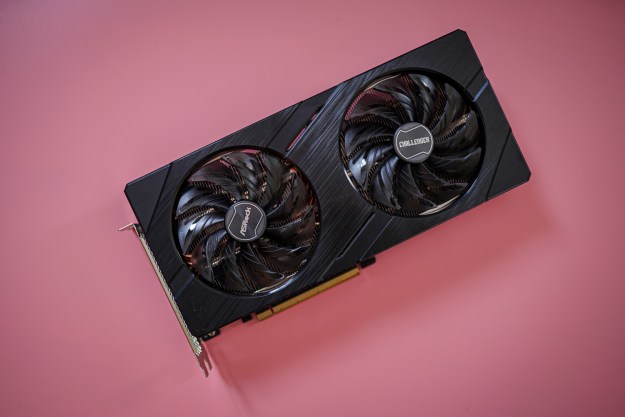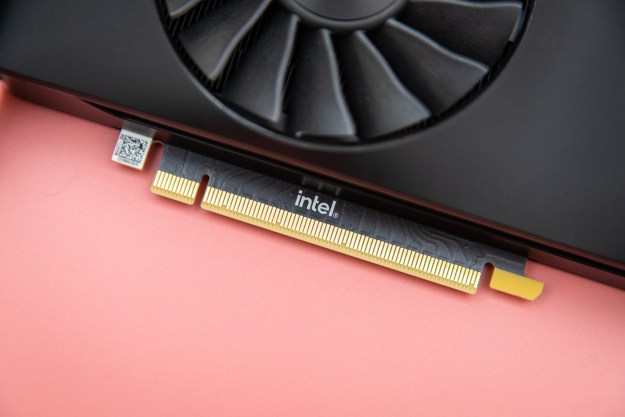
“The Intel Arc A580 is the budget GPU PC gamers have been begging for.”
- 60 fps gaming at 1080p
- Readily available below $200
- Supports Intel's XeSS
- Dual slot
- Driver issues
- Power-hungry
If I had to sum up the year in PC gaming in a single trend, it would be that graphics cards are just too expensive. It feels like, even among the best graphics cards, you’re getting less frames for your dollar. Intel’s Arc A580 is one of the few exceptions, and it’s shockingly good for the price.
It’s $180, which is a price that AMD and Nvidia abandoned a few years ago. And it’s a true budget GPU, a workhorse 1080p graphics card that will just play your games without any fancy bells and whistles. It has a few problems, and I’m still apprehensive about flat-out recommending an Intel GPU, but if you’re on a strict budget and don’t mind living on the edge of future support, the A580 fills a gap that other brands just aren’t touching.
Meet the A580

Intel didn’t make a splash with the A580 like it did with the A750 and A770, so let me get you acquainted. It’s $180 at list price, though I’ve seen some models drop down to $170l.
You can see how it stacks up to the rest of the range below. You’re getting most of the cores of the $230 Arc A750, but with a slightly lower clock speed and lower overall power draw. The key spec here is the 8GB of VRAM, which is great to see on such an inexpensive GPU.
| A770 | A750 | A580 | A380 | |
| Xe Cores | 32 | 28 | 24 | 8 |
| XMX Engines | 512 | 448 | 384 | 128 |
| Ray tracing cores | 32 | 28 | 24 | 8 |
| Clock speed | 2,100MHz | 2,050MHz | 1,700MHz | 2,000MHz |
| VRAM | 8/16GB GDDR6 | 8GB GDDR6 | 8GB GDDR6 | 6GB GDDR6 |
| Memory bus | 256-bit | 256-bit | 256-bit | 96-bit |
| PCIe interface | PCIe 4.0 x16 | PCIe 4.0 x16 | PCIe 4.0 x16 | PCIe 4.0 x8 |
| Power draw | 225W | 225W | 175W | 75W |
| List price | $330 (8GB), $350 (16GB) | $230 | $180 | $140 |
AMD’s last attempt at a GPU around this price — the infamous RX 6500 XT — came with a measly 4GB of VRAM for $200. As I’ll get to in my benchmarks, some modern games still stress 8GB of VRAM, as we’ve seen with more expensive GPUs like the RTX 4060 Ti.
As mentioned, AMD and Nvidia don’t have a GPU this generation that directly competes with the A580, but there’s one older GPU available around the same price. AMD’s RX 6600 is selling for around $200, which is still between $20 and $30 more expensive than the A580. Other budget options like the RTX 3050 and RX 6600 XT aren’t really in the conversation considering they sell for around $230. At that price, you’re better off with Intel’s Arc A750.
Performance
The A580 has a great price, but how about performance? It’s not a showstopper, but it’s hard to expect that at this price. What you’re getting for $180 is performance above 60 frames per second (fps) at 1080p with Ultra settings in most games, which is exactly the mark a GPU in this class should hit.
Starting with 3DMark, the A580 looks insane. It blows past AMD’s RX 6600, which is its most direct competition, and it even manages to beat the Nvidia RTX 3060 and AMD RX 7600, both of which sell for close to $300. However, the A750 also posts these high results. Based on past Arc GPUs I’ve tested, they show much higher performance in 3DMark than competing GPUs. We can see how that’s the case when digging into the real games I tested.
The scripts are flipped when looking at Assassin’s Creed Valhalla, with the two Arc GPUs being beaten by everything else. That’s not surprising considering all of these cards are more expensive than the A580, but it’s a better illustration of where the GPU lands with performance. The upside here is that you’re getting most of the performance of the A750, just for $50 cheaper. The same was true in Forza Horizon 5 and Hogwarts Legacy, where the two Intel GPUs posted identical performance. And in all three cases, we’re seeing performance above 60 fps with maxed-out settings.
We need to address the RX 6600 comparison, though, because that GPU looks much faster in these three games. Looking at titles like Cyberpunk 2077 and Red Dead Redemption 2, however, the A580 actually manages a small win. Similarly, in Horizon Zero Dawn, the A580 and RX 6600 are evenly matched. I believe the RX 6600 still manages a small performance lead overall when looking across the suite of games I tested, but it’s also between $20 and $30 more expensive than the A580.

Moving onto some newer titles, the A580 edges closer to that 60 fps mark. In Returnal, it just managed to pass 60 fps, meaning you’ll see some dips during actual gameplay. It’s not too big of an issue considering I’m testing at the highest graphics preset with no upscaling assistance from Intel’s own XeSS or AMD’s FidelityFX Super Resolution (FSR). But for newer, more demanding titles, the A580 may not cross that 60 fps line with all of the settings turned up.
It also runs into issues in areas that are heavy on the VRAM. Unfortunately, 8GB is still limiting, even at 1080p, which you can see in both The Last of Us Part 1 and Resident Evil 4. The Last of Us Part 1 is especially interesting, as you can see the RTX 3060 shoot ahead of the other cards due it to packing 12GB of VRAM.
That limitation is acceptable for a $180 graphics card, especially when looking at Nvidia’s RTX 4060 at $300 and AMD’s RX 7600 at $280. The worst case in these VRAM-limited titles is that you’ll need to bump down to the High preset.
Overall, the A580 still provides compelling performance. You’ll manage about 60 fps in games from the last few years at the highest graphics settings. And for other popular, less demanding PC games like Lethal Company, Rust, and Counter-Strike 2, you can expect far higher frame rates. It’s important to recognize the limitations of this GPU so you can work within them, though.
Newer games, particularly those that lean on the demanding side of things like Alan Wake 2, will likely make you compromise. That may mean lowering your graphics settings or looking to upscaling depending on the game. Ray tracing is mostly out of the question, too. The A580 is capable of ray tracing, but you’ll likely need to settle for a 30 fps target with ray tracing turned on. Even then, in some games, you’ll need to drop your settings. This is a 1080p graphics card that’s most comfortable at High to Ultra settings without ray tracing, and for the price, that’s all I can ask for.
Driver issues

Performance is very good for the A580 considering the price, but there’s a big factor in picking up an Intel GPU. There are still issues with its drivers. Intel has fixed the majority of performance problems due to its drivers, often releasing new updates that double or even triple performance in titles that used to struggle with the GPUs. Intel is still deep in a game of whack-a-mole, though, which means you may occasionally stumble upon a game with lower performance than you’d expect.
A great example of that is Starfield. At launch, Intel GPUs inexplicably wouldn’t launch the game. The title works now, but with far lower performance than you’d expect out of the GPU. These situations aren’t common, but they happen enough that it’s worth pointing out. If you’re interested in the A580 and there’s a particular game you want to play, I highly recommend looking for a YouTube video or article showing the performance of the card in that game. No reviewer can test every game with every GPU, but you can learn a lot from the swath of benchmarks available on the internet.
In addition, discrete graphics is still a new venture for Intel. Arc is the first generation, and although Intel has committed to releasing at least four generations of GPUs, it’s possible that will change. That doesn’t automatically make the A580 a bad buy, but it doesn’t have quite the same staying power as an Nvidia or AMD GPU, at least right now. Be prepared to upgrade in a few years regardless.
Plenty of 1080p power

We’ve been hurting for a true budget graphics card. Even considering some driver concerns with the A580, it’s a budget graphics card that delivers 60 fps at 1080p in most games. You can realistically build a PC with this GPU for around $600, which is a mark that PCs haven’t been to hit for a few years. That’s driven by the A580, as the cost of entry with most modern GPUs is at least $300, and that’s before you get to all of your other components.
It will be outclassed in a few years as games become more demanding and cheaper GPUs become more powerful, but it fills a hole right now that AMD and Nvidia are ignoring. It can handle lightweight games with ease while still offering playable frame rates in more demanding titles, and we haven’t had a GPU that hits a balance like that in a few years.
Editors' Recommendations
- Intel said AMD’s Ryzen 7000 is snake oil
- I fell in love with this adorable mini gaming PC
- Nvidia’s next GPU might follow Apple’s lead — and not in a good way
- AMD finally announced the GPU I’ve waited months for
- Intel surprise launched a new graphics card, but it doesn’t make any sense














